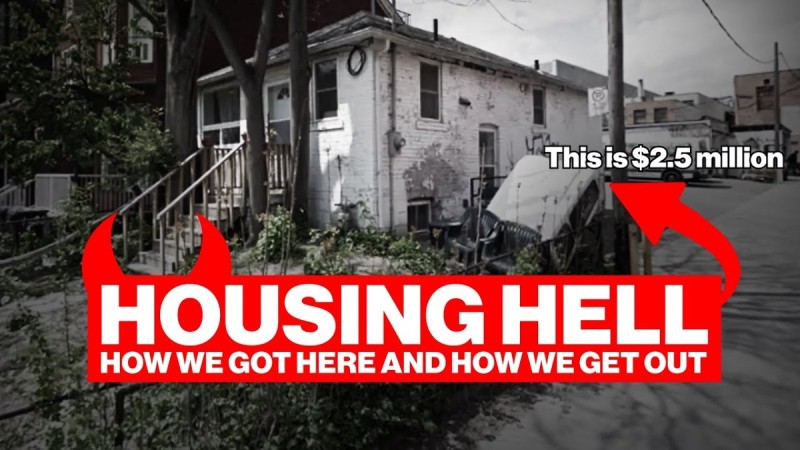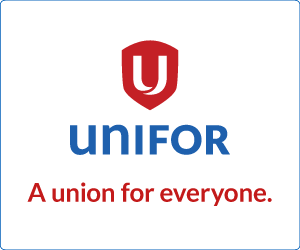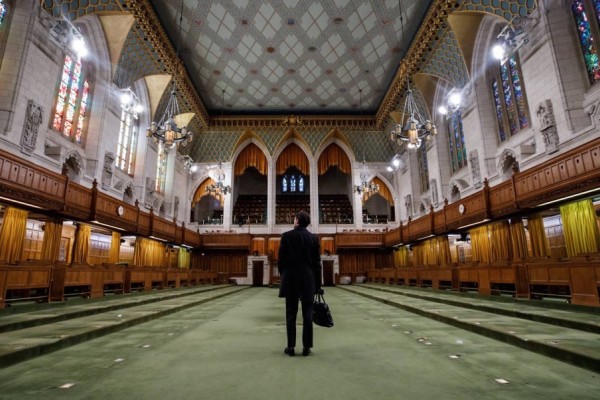Debunking Poilievre’s housing ‘documentary’
Tory leader proposes measures that will further enrich the same developers and investors who already own most of our housing

Still from Conservative Party leader Pierre Poilievre’s mini-documentary, “Housing hell: How we got here and how we get out.” Image from YouTube.
“Housing Hell,” Pierre Poilievre’s mini-documentary on the housing crisis, has racked up millions of views on X (formerly Twitter) and YouTube. Stretching to 15 minutes in length, the slick video contains some useful statistics. Its free market libertarian capitalist view of the crisis can be seductive to sections of the working class who are looking to understand, in Poilievre’s words, “How we got here and how we get out.”
However, while it recognizes the problem, the video merely proposes to give more power to the private corporations and developers that have been profiting from Canada’s housing (scarcity) crisis, all while attacking the very municipalities that are promoting alternatives like the expansion of public housing. It is important to debunk the myths that permeate Poilievre’s narrative in order to build momentum behind solutions that can actually solve the housing crisis to the benefit of ordinary working Canadians and marginalized communities.
Housing, after all, is only rising as an issue of vital importance in Canadian politics. According to polling by Nanos Research, 14 percent of Canadians cite housing as their top concern, second only to inflation at 18 percent. As the incumbent party presiding over this crisis, the Trudeau Liberals have the confidence of just 16 percent of Canadians who believe they are best equipped to find solutions. The Conservatives have deftly cornered this issue in advance of the next election, which could happen as early as next year.
Housing hell: How we got here and how we get out. pic.twitter.com/vVLsXMVM35
— Pierre Poilievre (@PierrePoilievre) December 2, 2023
Poilievre’s thesis
Poilievre narrates the “Housing Hell” video and begins with an appeal to young people who have seemingly given up on ever owning a home. This rhetoric has been effective for the Conservative leader, and has seen the Tories “rejuvenated” by gains among millennials and younger Canadians. For example, in the 2015 election, 45 percent of those aged 18 to 25 voted Liberal, and only 20 percent voted Conservative. These numbers have now flipped, with one poll of under 30-year-olds giving Poilievre 39 percent, while Trudeau languished at 16.
Early in the video, a statistic flashes across the screen: “66% OF AVERAGE MONTHLY INCOME FOR PAYMENTS ON AVERAGE HOME.” Poilievre goes on to state that it takes about 25 years to save up for a down payment on a house in Toronto, Canada’s largest city, while the average rent nationwide has doubled since 2015.
Predictably, 2015 is a key year for Poilievre, as it marks the start of Justin Trudeau’s reign as prime minister.
Eight years ago, the average rent of a one-bedroom apartment was $973, compared with $1,871 in 2023. Over that period average mortgage payments have shot up from $1,418 to $3,562, and minimum down-payments from $22,635 to $51,060.
Poilievre wields these shocking statistics to great effect, contrasting them with the fact that housing costs were only 40 percent of the median income in 2015—although we may add that even 40 percent is well above the 30 percent recommended by the Canada Mortgage and Housing Corporation (CMHC).
Deficits, money printing, and inflation
Having quickly laid out the central facts of Canada’s housing affordability (and availability) crisis, the video then turns to explaining how we got here. This is where the trouble emerges. Poilievre’s first target is the Trudeau government’s penchant for deficit spending and “quantitative easing” (QE)—also known as money printing. This, according to the Conservatives, has increased the money supply eight times faster than GDP growth over the last three years, thereby fuelling inflation. Poilievre then flexes his populist bonafides by detailing how Bank of Canada QE bond buy-backs guarantee a big profit for “wealthy investors whose banking connections get them to the front of the line.”
The Conservative leader has a point here. Increasing the money supply without growing the goods and services in the economy does dilute the value of money, leading to inflation. But he conveniently omits other drivers of inflation, such as price gouging. One study estimates that 2022 corporate profits as a share of GDP shot up 25 percent from their pre-pandemic highs. “In dollars and cents terms,” reads an analysis published by Canadians for Tax Fairness, “2022 profits were $275 billion higher than 2019.”
Other studies have shown that financialization (the process by which business elites gain greater control over economic policy) is a major driver of increased property prices. In Ontario and British Columbia almost 40 percent of housing stock was owned by corporations or multi-property owning investors and speculators in 2020. Poilievre cites Bank of Canada data showing how home purchases by investors doubled in 2021. However, despite highlighting the role of investors in artificially increasing the cost of housing, “Housing Hell” ends up proposing measures that will further enrich the same property developers and investors that already own a massive chunk of Canada’s housing stock. More on this later.
Next, Poilievre aims his ire at the Bank of Canada’s decision to increase interest rates to tame inflation, claiming this would not be necessary if there were no “inflationary deficits.” In doing so, he oversimplifies the situation by saying that balanced budgets will lower inflation, which in turn will lower the high interest rates that are jacking up mortgage payments. But a program of balanced budget-induced austerity would do nothing to tackle ‘greedflation.’ It would also take a long time to have a noticeable effect while ignoring the reason for the deficits in the first place.
A significant driver of Canada’s ballooning federal debt is pandemic-era government assistance programs, which the Conservatives largely supported. The Tories even called for rent subsidies and loans to businesses to be more generous. The far-right Fraser Institute estimates that the cost of Canada’s COVID programs was $359.7 billion. Of this figure, approximately $110 billion went to workers in the form of the Canada Emergency Response Benefit (CERB) and related programs. The remainder, which represents the overwhelming majority of the debt Poilievre is complaining about, was distributed in the form of wage subsidies, preferential loans, and other forms of corporate welfare that Conservatives also voted for. If Poilievre was to be consistent he would demand that corporations, especially profitable ones that did not need the support, pay back the government largesse they received during the pandemic.
Pierre Poilievre announcing his housing plan outside SkyTrain VCC-Clark Station in Vancouver, September 14, 2023. Photo courtesy the Conservative Party of Canada/X.
Distorting housing data
Poilievre goes on to detail the lagging rate of housing construction in Canada. To wit, in 1972, when Canada had a population of 22 million, 230,000 homes were built each year. In 2022, with a population of nearly 40 million, we built just 220,000 homes.
The CMHC estimates that, at this rate, Canada will be short 3.5 million homes by 2030.
“Housing Hell” blames high interest rates and “red tape” for this gap, both of which are wrapped up in the term “government.”
Poilievre then goes on to quote a study by the C.D. Howe Institute claiming that in Vancouver, once you subtract construction costs, there is an additional $1.3 million added to an average house. He calls this the “gatekeeper gap” and blames it on red tape and government bureaucracy.
However, when you actually read the study, it becomes apparent that Poilievre’s claims are overstated. According to C.D. Howe, “these metrics are inherently about the gap between construction costs of housing and the end cost to buyers. This is a measure of the gap, but it says nothing about the end incidence of these charges.” The gap could equally be due to profiteering by construction companies or land speculators. The study even admits that some municipal fees to build local infrastructure may in fact bring back more value to the property.
Dog whistles and attacks on municipalities
Alt-right outlets are complaining that Poilievre didn’t take the overtly racist line of blaming the housing crisis on immigrants and “Trudeau’s open borders mass immigration agenda.” This is deliberate on the part of Conservative strategists, who are making gains with formerly Liberal-voting immigrant communities. When attacking red tape and gatekeeping, “Housing Hell” twice featured a picture of Chinese-Canadian Toronto Mayor Olivia Chow. It is more than a bit unfair to blame Chow for the housing crisis, given that she has barely been in office for six months. One can reasonably surmise that she was targeted as her race and NDP background make her a triggering figure for the right. If they wanted to have a poster boy for the failure to build affordable housing in Ontario, surely Doug Ford would have been a more fitting candidate.
The meat of the Conservative solution to the housing crisis comes in the form of an attack on grants to “city governments that block home building,” criticizing these supports because they would result in the hiring of “more gatekeepers.”
While restrictive municipal zoning regulations have played a role in slowing development, Poilievre’s proposals would end up cutting many of the programs put in place to renovate and build social housing.
Poilievre plans to hold hostage $4.5 billion of federal grants to the municipalities until they can build 15 percent more housing per year. How the cities and the regions are supposed to meet this target, when they are starved of the very funds that help them build housing and related infrastructure, is never mentioned. To make matters worse, federal support would be withheld until the houses are completed—depriving municipalities of essential funds for years.
Meanwhile, Canada’s private housing development companies are doing better than ever. The residential construction industry in Canada increased its profitability in 2021 to 13.2 percent, up from 12.5 percent the previous year. The volume of the residential real estate market has grown by approximately 29 percent over the last five years, to US$5.93 trillion in 2023, and is projected to grow at a greater than four percent annual rate over the next five years.
REITs, or real estate investment trusts, are another contributor to the housing crisis that is never mentioned by Poilievre. These private funds enjoy a preferential tax status and have yielded an average 9.7 percent return since being registered on the Toronto Stock Exchange in 1997. Over 340,000 units, or 20 to 30 percent of purpose-built rental homes are owned by REITs. They have been implicated in ‘demovictions’ of low-income tenants and a general drive to increase rents to maximize investment profit. REITs, along with large pension funds and private equity firms, have been gobbling up Canadian real estate at an alarming rate.
Canada’s housing sector is largely dominated by private interests, and it is no longer the act of a radical to say so. Notwithstanding Poilievre’s rhetoric, it is important to understand the current crisis as a failure of unregulated capitalism. The profit motive is demonstrably failing to meet the basic human need for shelter.
Public vs. private
The Conservative housing agenda, as articulated in Poilievre’s documentary video, will focus mostly on maximizing the profits of developers while ignoring the creeping dominance of real estate conglomerates and disregarding the urgent need to add more affordable or public options to the housing mix. One only needs to look at the Ford government in Ontario, which, in the face of a massive public backlash, scuttled plans to hand a portion of protected lands around Toronto to his developer friends, to see what happens when guardrails are lowered and developers are permitted to “build, build, build.”
Another proposal in “Housing Hell” is the privatization of 15 percent of federal government buildings and thousands of acres of federal land. Experience has shown that giving more opportunities to profit, with no conditions, does not result in the construction of low-cost, high quality housing. Instead, speculators will either build luxury accommodation that yields a higher profit, or hoard the land awaiting a better return.
The only way that Poilievre’s balanced budget austerity regime would bring down inflation and interest rates is if cuts to services (and their associated layoffs) spark a recession—as has happened in other countries. But this means the cure is sure to be worse than the disease, with rising unemployment and reduced government revenues increasing the debt-to-GDP ratio. Withholding essential financial support from cities, particularly at a time of record immigration, would make matters even worse.
Instead of more capitalism and profits for the same corporations that have presided over this crisis, history shows us that key solutions can be found in direct state intervention. Prior to the cuts by the Chretien and Martin Liberals in the 1990s, Canada built approximately 16,000 non-profit or co-op homes every year. In 1970, more than 40,000 homes were built by the federal government.
Public and social housing also has the effect of acting as a negative price pressure on the private market. It provides a low-cost competitor and reduces demand by taking people into the non-profit sector. By attacking these programs, the Conservatives are signalling that they would allow private developers to raise housing costs without fear of any public competition.
During the 2004 election, then NDP leader Jack Layton famously accused Paul Martin of being responsible for the deaths of homeless people due to the public housing cuts he oversaw in the 1990s (he even wrote a book about the issue). At the time of his remarks, Layton suffered a media backlash, but he has been vindicated by history. Thirty years of deregulated land use, unfettered access and subsidies for developers, and a shrinking role for the public sector has got us to our present predicament.
Toronto hopes to build 65,000 rent controlled homes by 2030, while the federal government’s Fall Economic Statement has advanced $1 billion to build 7,000 new affordable homes. But this is just a drop in the bucket compared with the 3.5 million homes the CMHC says we need to build. Under a Poilievre government, even these limited measures could be declared “red tape” and summarily axed.
Unless something unexpected happens, the Conservatives are set to win the next federal election and put their free market libertarian capitalist housing policy into practice. But no amount of gifts and incentives can force private developers to build the decent quality, low-cost, housing that is so desperately needed. If corporations can make more money from speculation, withholding supply, and building luxury units, this is what they will do. Already, Canada has 1.3 million vacant homes that are being used as speculative investment vehicles rather than meeting the need for accommodation.
We cannot allow Pierre Poilievre to own the issue of housing. It is essential to build momentum behind real solutions, not free market dogma, to solve the crisis. Only this can end the housing hell afflicting Canadian families.
Alex Grant is a writer and organizer based in Toronto.










